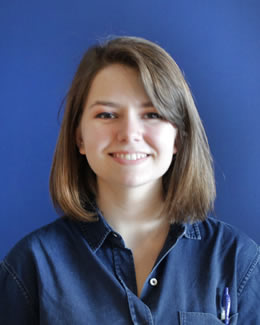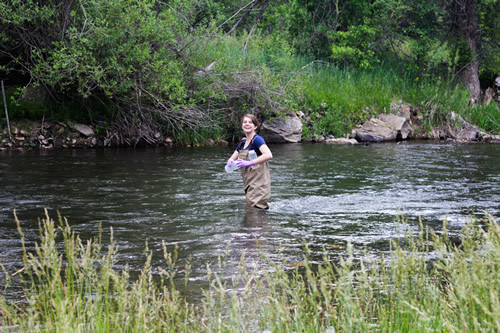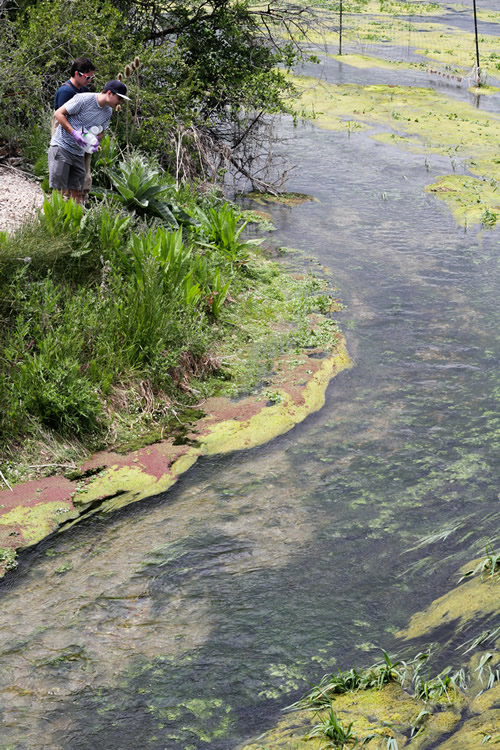iUTAH Team - Undergraduate iFellows

Natasha Griffin
Brigham Young University
Mentors:
Faculty: Zachary Aanderud, BYU
Graduate: Erin Jones, BYU
Research Focus:
Research Focus Area 1
Major:
Environmental Science
Biography:
Natasha Griffin grew up in Payson, Utah. She is a sophomore at Brigham Young University majoring in Environmental Science and minoring in Writing and Rhetoric, and she is especially interested in polar and aquatic ecology. After attending graduate school in ecology, she hopes to do research and write about the environment.
Weekly Recap:
Week 1 | Week 2 | Week 3 | Week 4 | Week 5 | Week 6 | Week 7 | Week 8 | Week 9 | Week 10 | Week 11
Week 1: May 18-22, 2015
In my first week as an iFellow, I did a lot of reading about the methods we'll be using for my project, E. coli source tracking and about microbial source tracking in general. My mentors and I met to set research goals for the next few months and I learned about how we do gene cloning and PCR in my lab. We also started ordering supplies so that we can begin creating a standard curve to judge our qPCR results against.
Week 2: May 25-29, 2015
I did PCR for the first time this week as we figured out which temperatures would work best with the primers we've been using to bind to human- and cow-specific bacterial DNA samples. I also learned how to do gel electrophoresis. I continued reading articles on microbial source tracking and researched all the primers we're using to target different Bacteroides species, one of the organisms we're using as a pollution indicator.
Week 3: June 1-5, 2015
This week we started training on DNA extraction. I filtered water samples and used an extraction kit and a spectrophotometer to determine DNA concentration. The results were a little weird, so we began planning an experiment that we'll do next week to determine which extraction methods work best. Our new primers arrived and the gene cloning kit should come soon so I've also been researching how plasmids are used to make standard curves for qPCR.
Week 4: June 8-12, 2015
I finally got to go sampling for my DNA extraction experiment this week, which was very cool. We filtered our samples and began the factorial experiment we designed. Our primers and cloning kit arrived. I also started that so we can start our cloning reaction as soon as we determine the best extraction method.
Week 5: June 15-19, 2015
After a few failures, we finally managed to extract good concentrations of DNA from the samples we took last week. We then did PCR for three different bacteria (E. coli, Enterococcus, and Pseudomonas), using the DNA we extracted as the template. The PCR product will be cloned into vectors for making qPCR curves. Along with my project, I filtered snow samples for another iUTAH project and began writing a quality control guide for pH data to be used by people monitoring data from iUTAH's GAMUT stations.
Week 6: June 22-26, 2015
No Entry
Week 7: June 29-July 3, 2015
This week, we did gradient PCR to find the best temperatures to use when amplifying different organisms' DNA. I learned how to do gel extractions to isolate particular DNA amplicon sizes from an agarose gel. I also made plates with antibiotic and growth medium to culture the E. coli cells we'll be transforming DNA for our standards into.
Week 8: July 6-10, 2015
This week we performed the cloning reaction to insert our PCR product into vectors, then transformed the vectors into the E. coli cells and cultured them on the plates we made. We selected some E. coli colonies from those plates to culture further and use for our standards after we sequence them to verify the amplicon we inserted is correctly oriented. I also got to spend a day in the Provo River watershed with the BYU iUTAH tech, Dylan, for sampling and calibration at the GAMUT aquatic stations.
Week 9: July 13-17, 2015
We extracted plasmid DNA from the colonies we cultured last week, PCR amplified it, and found that it was the correct size after running it on an agarose gel. Next we'll sequence it to see which Enterococcus species the DNA belongs to and make dilutions of the DNA to use as qPCR standard curves. We amplified Bifidobacterium and Pseudomonas DNA as well so that we can make standards for them. I also spent time on my poster and presented it at the iUTAH symposium, which was terrifying, but it was great to meet so many other people working with iUTAH and to gain presenting experience.
Week 10: July 20-24, 2015
No Entry
Week 11: July 27-31, 2015
No Entry




